







In this field lab, ten growers explored replacements for polyethylene - a non-recyclable, fossil-fuel-derived material used in mulches. A range of crops were trialled including brassicas, onions, lettuce, beetroot, spinach, leeks, onions, blackcurrants and young top fruit trees.
While plastic mulches are effective in managing weeds, the environmental problems associated with their use are becoming increasingly clear. This project aimed to find viable alternatives to fossil-derived plastic mulches.
The trials explored a range of commercially available non-degradable and biodegradable solutions, including starch-based film mulches, woodchip, compost (inc. municipal compost), cardboard, hay and grass clippings. These were compared to plastic/ fossil fuel mulch in terms of:
On some sites supplementary data was also be collected on the following:
This group was supported by AHDB funding through its partnership with the programme.
These trials build on CAWR's OrganicPlus trials, and are complimented by a life-cycle analysis of the materials by CAWR partners, to understand the wider impact on sustainability.
Instead of physical workshops to help instruct the group on data collection and mulch laying, the researchers and coordinator have created a how-to guide and instructional videos.
If you are exploring non-plastic mulches and would like to follow the protocols of this trial, longer versions of these can be found in the knowledge hub (hyperlink to knowledge hub) section of the website.
A range of different mulches were compared to the control of black plastic film or woven plastic. These included woodchip, grass, cardboard, under-sown mulches, green waste, straw, hay, wood, compost, biodegradable film
For each crop tested at least one test plot was set up. The plots were at least 20m long where possible. The different mulches were arranged randomly within the trial plots. The mulch was then applied according to normal practice.
All of the farmers and growers collected data on the following parameters:
Many chose to also collect data on soil moisture and pest/disease damage, and a few will measure crop development, microbial activity (measured through respiration rate) and soil nutrients.
A guide to laying biodegradable plastic mulches can be found in the knowledge hub section of the website.
A total of 10 growers will take part in trials in 2021, which includes 6 new sites:
Each site will collect data on weeds, yields, costs and qualitative observations. Some are also assessing microbial activity, pest and disease damage, soil nutrients, etc.
There were more growers interested in the trials in the second year. These included:
These growers took soil samples to see if any microplastics or plasticisers were released into the soil from biodegradable and non-biodegradable mulches.
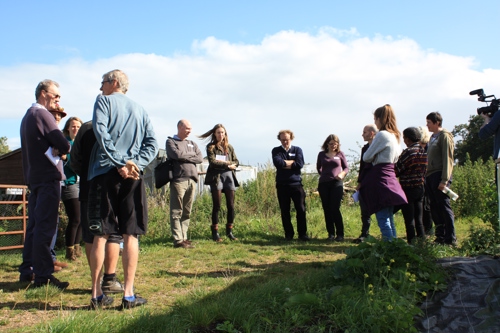
Current practices of the new growers:
Gibside community farm primarily grow under biofilm mulch. They carried out a trial comparing leeks under woodchip and biofilm mulch and found no difference. They think using mypex to keep weeds down before crop has established, then removing it, could be a good option. Would like to trial green manure particularly on brassicas. Tried small clover and some vetches as a living manure.
A recommendation from the kale grower is to try it on a single harvest crop, otherwise data collection takes a lot of effort!
The tea grower planted tea bushes in 2017 and is primarily interested in using sheep fleeces. They have a 5 acre orchard. The benefits of wool are that it is a slow releaser of nitrogen, it prevents runoff, holds water, preventing the soil from drying out, and it insulates soil. Tea plants need very high levels of nitrogen
Garden Organic will perhaps try biofilm and straw.
Sue Johnson - kale, celeriac, tomatoes, lettuce - would like to try sheep's wool if she can find a source of it.
Francis at CAWR says: "We have only made some preliminary tests so far but we have found a big range of potentially harmful chemicals in the commercial paper mulch that Anton used - I think these may come from the waxy coatings they give the paper to make it more durable. This is not to say that these are actually released into the soil at detrimental concentrations but it is interesting to note that paper is not necessarily better than plastic in this regard."
The blackcurrant grower from the previous year's trial will continue with the trial. He is keen on testing out logistics of how you lay woodchip on a field scale using a sileage feeder. He has found someone who would lend them one. He also wants to try and increase the water level under the woodchip. The blackcurrant grower's issue of rolling out at scale was also identified in the apple scab field lab he took part in.
Tom Appleman and the blackcurrant grower are both interested in looking at how woodchip will impact soil nutrients.
Andrew Adams at the prison trial site is growing potatoes, courgettes and onions this year. He is using three mulches. He is also growing chillies in glasshouses and will do some mulch trials in those including cardboard (as its a waste product on site); woodchip or straw; biofilm and mypex.
This year there has been very little interest in biofilm amongst all growers, and more interest in using on-farm, loose, available mulches. The blackcurrant grower will continue to use biofilm, but since he knows what it does (because it behaves in the same way as a conventional plastic) he has no need to trial it.
His observation is that “drip line with laying biofilm is phenomenal as they have a microclimate there and they are 1 year ahead in growth than other blackcurrant growers.”
The majority of quantitative data from this year has now been collected. This, alongside qualitative information on growers' observations/experiences, suggests:
However, there were some common observations:
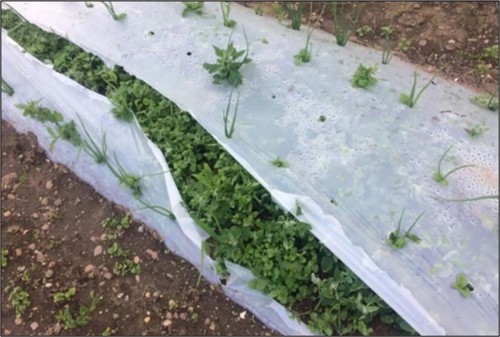
The blackcurrant grower hopes to use woodchip as a mulch as they have access to willow and spruce on farm, though the amount of willow woodchip required to scale this across the farm is a potential barrier.
The blackcurrant grower has been chipping willow on-farm as a mulch. "It raised more questions than answers but we needed to look at crop vigour so after some months started counting the number of branches". Greater vigour with potato starch but higher number of deaths and dwarfism amongst the bushes.
Large woodchip - bushes grew bigger but with less vigour than biofilm. Could be because the dripline was set up for the biofilm and the ones under the woodchip might have just been thirsty. it barely rained in May and June so they fully relied on the drip. where the biofilm ripped, the cuttings were subsumed with weeds. They need to repeat the trial again to check the water is there for the woodchip.
Another problem is the logistics of getting 20 thousand cubic metres of woodchip onto a field (which is needed for 24 acres of blackcurrants). The logistics of doing their own woodchipping and spreading on-farm is the barrier to doing it at the scale of their farm. It's not impossible - if there was a very clear benefit of doing woodchip, we could change the whole ecology of the farm to do it.
The potato starch is something we know how to use - if there was a buying group to reduce the cost by buying in a large enough quantity of the film, that'd be the way to go.
Sue Johnson - layer of hay with a layer of brown paper underneath worked really well. Paper rotted under the hay but the hay stayed there and kept the weeds down.
Anton has been coordinating garden organic members' trials - 70 completed results returned. These trialled weed fabric, bioplastic mulch, and paper mulch on small scale plots growing onions over summer 2020. These trials saw a yield increase of 10% across all mulches; paper mulch was quickest to break down; bioplastic mulch was difficult to work with and there were concerns over the energy used to make it; paper mulch was the most popular.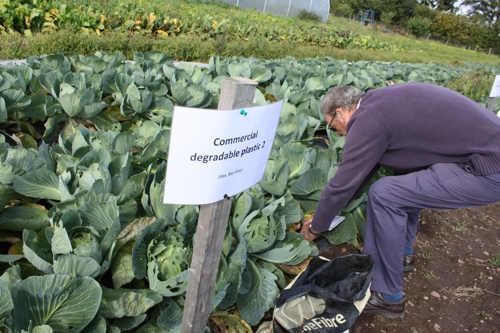
The field lab will continue into another year to allow growers to run trials who had expressed interest but were not able to take part this year. This includes growers interested in looking at wool as a mulch..
More information on this field lab, including individual grower data and a video of the trial, can be found in the reports and results section of this field lab page.
Trials this year are taking place at 5 sites.
1) Onion trial at a community farm in Warwickshire, recording yields and weed coverage. This site will compare an unweeded plot with no mulch, a weeded plot with no mulch, and plots of either woven polypropylene, polythene, paper or commercial biodegradable films.
2) Kale trial at a market garden in mid-Wales, recording yields, costs, weed & pest damage. This farm will trial compare biodegradable film to grass cuttings, woodchip and an undersown living mulch.
3) Blackcurrant bush trial at a commercial farm in Essex, recording growth of new bushes planted into the mulches, the number of dwarf and dead bushes and weed coverage. This farm will trial out biodegradable film and willow woodchip in two sizes compared to a unmulched bare earth.
4) Organic farm in Leicestershire, comparing cardboard, hay and grass clippings.
5) Organic community farm in Newcastle-upon-Tyne, comparing woodchip, woven polypropylene and biodegradable film.
Unfortunately, although ten growers initially signed up to the trial, several growers had to drop out due to the impacts of Covid-19 on, slowing the delivery of mulches, hindering some people's ability to get out on site or have colleague support to run their on-farm trial. These will have the option to commence their trial in the second year of the field lab.
Instead of physical workshops to help instruct the group on data collection and mulch laying, the researchers and coordinator have created a how-to guide and an instructional videos. If you are exploring non-plastic mulches and would like to follow the protocols of this trial, longer versions of these can be found in the knowledge hub section of the website. This includes tips for laying biodegradable mulch. A shorter version is below.
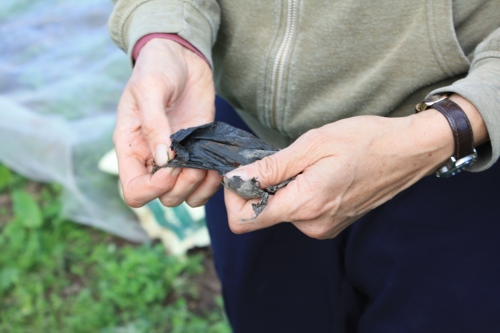
A range of different mulches will be compared to plastic film/ standard practice including biodegradable film; woodchip; hay; grass cuttings; cardboard; paper and straw.
For each crop you are testing arrange the ‘plots’. If you have the space and time to repeat the layout more than once (known as a ‘replicate’), it will make the data more robust but additional replicates are optional.
Weeds
Yield
At the end of the growing season record the total yield in each plot
Qualitative/ Visual observations
At same time as assessing weed burdens, record any general observations of interest. For example, ‘serious slug damage’, or ‘the crop under mulch x seems to be developing faster than under crop y’
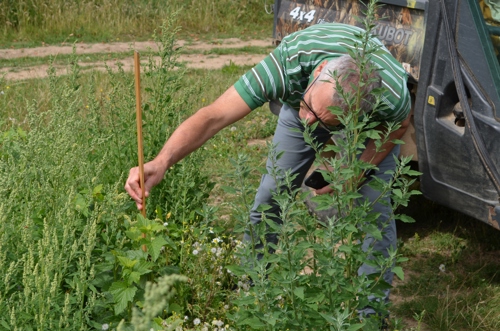
Costs
Throughout the trial record any costs, for example:
Soil Conditions
Soil Nutrient status Pest and disease damage
Before the mulch goes down and again immediately after it come up at the end of the season, for each strip:
Pest and disease damage
At same time as weed assessments score damage severity from 1 – 5 and record different pest species/ diseases if you can identify them. AHDB Horticulture are particularly interested in downy mildew on onions.
Crop development
At fortnightly intervals record the stage of the development of the crop in each strip.
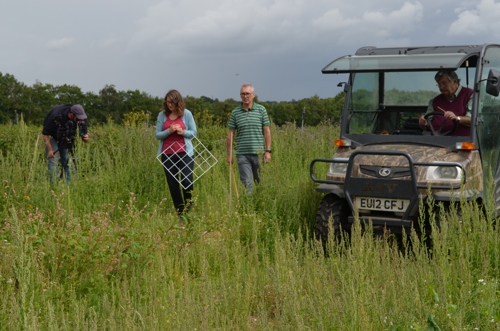
Soil microbial activity
At harvest, use the Solvita testing kit provided to assess the level of microbial activity. Step by step instructions will be provided with the kit
Earthworm counts Summary of data collection activity
At harvest, assess the number of earthworms under each strip using the AHDB: How to count earthworms protocol.
Growers, gardeners, mulch suppliers and researchers met at Garden Organic to agree on the objectives and methods for the trial. There was a wide representation of growers, including (soft fruit) crops; field vegetables; small-scale farms and protected cropping.
The group discussed the following:

Launch meeting at Ryton Organic Gardens
February 2020
March 2020
April 2020
September 2020
March 2021
July 2021
September 2021
March 2022

Sustainable Farming Consultancy
Tony has 18 years experience working in organic and sustainable agriculture in the UK and internationally, and is a member of the Institute of Organic Training and Advice. He studied Agricultural and Environmental Sciences at the University of Newcastle upon Tyne, and has a Masters in crop pest management from Imperial College, London. Tony was a key figure at Organic Centre Wales for nearly 15 years and left in September 2015 to set up the Sustainable Farming Consultancy.

University of Coventry
Coventry

